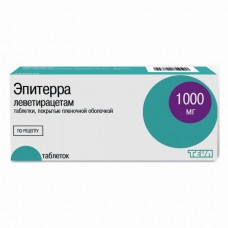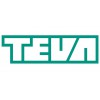Expiration date: 09/2025
Release Form: Tablets film-coated
Packaging: 60 pcs.
pharmachologic effect: Anticonvulsants
testimony
Monotherapy:
partial seizures with secondary generalization or without adults and children older than 16 years with newly diagnosed epilepsy.
In the combined therapy:
partial seizures with secondary generalization or without epilepsy in adults and children older than 6 years,
myoclonic seizures in adults and children older than 12 years with juvenile myoclonic epilepsy,
primary generalized convulsive (tonic-clonic) seizures in adults and children older than 12 years with idiopathic generalized epilepsy.
Contraindications
hypersensitivity pyrrolidone derivatives, or other components of levetiracetam Epiterra preparation
Children up to age 16 years as monotherapy partial seizures with secondary generalization or without at newly diagnosed epilepsy,
Children under 6 years in the complex treatment of partial seizures with secondary generalization or without epilepsy,
Children up to age 12 years in the complex treatment of myoclonic seizures in juvenile myoclonic epilepsy, and primary generalized convulsive (tonic-clonic) seizures with idiopathic generalized epilepsy,
body weight less than 25 kg.
Carefully:
severe liver dysfunction, severe renal dysfunction (creatinine clearance less than 50 mL / min), age over 65 years, the simultaneous application of sulfonamides, probenecid, NSAIDs, methotrexate, depression, suicidal behavior.
Pregnancy and breast-feeding
hypersensitivity pyrrolidone derivatives, or other components of levetiracetam Epiterra preparation
Children up to age 16 years as monotherapy partial seizures with secondary generalization or without at newly diagnosed epilepsy,
Children under 6 years in the complex treatment of partial seizures with secondary generalization or without epilepsy,
Children up to age 12 years in the complex treatment of myoclonic seizures in juvenile myoclonic epilepsy, and primary generalized convulsive (tonic-clonic) seizures with idiopathic generalized epilepsy,
body weight less than 25 kg.
Carefully:
severe liver dysfunction, severe renal dysfunction (creatinine clearance less than 50 mL / min), age over 65 years, the simultaneous application of sulfonamides, probenecid, NSAIDs, methotrexate, depression, suicidal behavior.
special instructions
If necessary, treatment discontinuation cancellation Epiterra drug recommended gradually reducing a single dose of 500 mg every 2-4 weeks. In adults weighing less than 50 kg is recommended to reduce the dose to 20 mg / kg every 2 weeks. In children with a body weight of 25-50 kg recommend reducing the dose to 10 mg / kg every 2 weeks.
Use of the drug Epiterra patients with renal impairment may require dose adjustment (see. "How to use" section).
During the administration of the drug can be observed Epiterra CNS side effects, including drowsiness, weakness, fatigue, psychotic and non-psychotic behavioral change, especially in the first month of therapy. Therefore, early treatment of patients must be set very carefully monitored.
Patients should be regularly checked for signs of depression, suicidal and obsessions, as a result of increasing the risk of suicide attempts in patients taking antiepileptic drugs, including Epiterra drug. In the presence of symptoms of depression and suicide attempts for patients and carers for them, should consult a specialist.
Recommended accompanying the phasing out of anticonvulsants in the translation between the patient to receive the drug Epiterra.
In patients with partial seizures during treatment with the drug there was a slight, but statistically significant decline in red blood cells that does not require an active clinical intervention.
Available data on drug use among children do not show any negative impact on its development and puberty. However, long-term effects of treatment on the children's ability to learn, their intellectual development, growth, endocrine function, sexual development and fertility are unknown.
Effects on ability to transport management and work with equipment
During drug treatment Epiterra should refrain from driving motor vehicles and activities potentially hazardous activities that require high concentration and psychomotor speed reactions due to the fact that there may be adverse reactions such as drowsiness, dizziness, blurred vision.
Composition
1 tablet contains:
Active ingredient: 500 or 1000 mg of levetiracetam,
Excipients: corn starch, Povidone (PVP K30), croscarmellose sodium, magnesium stearate
Dosing and Administration
Inside, drinking plenty of fluids, regardless of the meal. The daily dose is divided into two equal portions for receiving two times a day.
Monotherapy with partial seizures with secondary generalization or without newly diagnosed with epilepsy:
Adults and children over 16 years. Starting dose - 500 mg, divided into two doses (250 mg, 2 times a day). After 2 weeks of therapy depending on the individual response and tolerability daily dose may be increased to an initial therapeutic dose of - 1 g (500 mg, 2 times a day).
The maximum daily dose - 3 g at (1.5 g, 2 times a day).
In the complex treatment of partial seizures with secondary generalization or without epilepsy:
Adults. Starting dose - 1 g, divided into two doses (500 mg, 2 times a day). Depending on the clinical response and tolerance of the daily dose can be increased up to a maximum dose - 3 g (1.5 g, 2 times a day).
Children older than 6 years. The initial dose of 20 mg / kg body weight, divided into two doses (10 mg / kg of body weight, 2 times a day). Depending on the clinical response and tolerance dose change is 20 mg / kg body weight may be performed every 2 weeks until the recommended daily dose - 60 mg / kg body weight (30 mg / kg of body weight, 2 times a day).
In the complex treatment of myoclonic seizures in juvenile myoclonic epilepsy, and primary generalized convulsive (tonic-clonic) seizures in idiopathic generalized epilepsy:
Adults and children over 12 years weighing more than 50 kg. The initial dose of 1 g, divided into two doses (500 mg, 2 times a day). Depending on the clinical response and tolerance of the daily dose can be increased up to a maximum dose - 3 g (1.5 g, 2 times a day).
Changes in the dose of 500 mg 2 times a day can be carried out every 2-4 weeks.
Side effects
The frequency of side effects were classified according to WHO guidelines: very often - at least 10%, often - at least 1% but less than 10%, infrequently - at least 0.1% but less than 1%, rare - at least 0 , 01%, but less than 0.1%, very rare - less than 0.01%, including isolated cases. Data post-marketing studies is insufficient to assess the incidence of adverse events in the population.
From the blood and lymphatic system: rarely - thrombocytopenia, leukopenia, rarely - neutropenia, pantsitemiya.
On the part of metabolism and nutrition: often - anorexia, rarely - increase / decrease in body weight.
On the part of the central nervous system: very often - drowsiness, headache, often - mood swings, emotional lability, depression, aggression, insomnia, nervousness, infrequently - conduct disorder, anger, anxiety, hallucinations, psychotic disorders, impaired memory, suicidal attempt, obsessions , amnesia, impairment of tactile sensitivity, dizziness, headache, hyperkinesia, tremor, balance disorder, confusion, paresthesia, rarely - personality disorder, including thought disorder, suicide, hyperkinesia, choreoathetosis.
On the part of the organ of vision: rarely - diplopia, blurred vision.
On the part of the ear and labyrinth disorders: often - dizziness.
The respiratory system, organs, thoracic and mediastinal disorders: often - cough.
On the part of the digestive tract: often - nausea, vomiting, diarrhea, abdominal pain, dyspepsia, rarely - pancreatitis.
On the part of the liver and biliary tract: rarely - laboratory abnormalities of liver function of normal, rarely - hepatitis, liver failure.
Skin and subcutaneous tissue disorders: often - skin rash, rarely - eczema, pruritus, rare - alopecia (in some cases, after the abolition of passing levetiracetam), toxic epidermal necrolysis, erythema multiforme, Stevens-Johnson syndrome.
On the part of the musculoskeletal and connective tissue disorders: rarely - myalgia, muscle weakness.
Other: often - general weakness, fatigue, rarely - nasopharyngitis, accidental trauma.
The risk of anorexia increased during concomitant use of topiramate and levetiracetam.
In some cases, after the abolition of levetiracetam alopecia held their own.
With the development of pancytopenia observed bone marrow suppression.
The most common adverse reactions in children in clinical trials were: vomiting, agitation, mood swings, aggression, emotional lability, conduct disorder, lethargy.
Drug interactions
Levetiracetam does not interact with antiepileptic drugs (phenytoin, carbamazepine, valproic acid, phenobarbital, lamotrigine, gabapentin and primidone), which in turn does not alter the pharmacokinetics of levetiracetam.
Levetiracetam in a daily dose of 1 g does not alter the pharmacokinetics of oral contraceptive ethinyl estradiol and levonorgestrel.
Levetiracetam in a daily dose of 2 g does not alter the pharmacokinetics of digoxin and warfarin.
Digoxin, oral contraceptives and warfarin did not affect the pharmacokinetics of levetiracetam.
Probenecid decreases the renal clearance of the primary metabolite of levetiracetam.
It is assumed that drugs are excreted through the active renal secretion, it is also able to reduce the clearance of the metabolite. Effect of levetiracetam on probenecid and other drugs with the same mechanism for removal (including NSAIDs, sulfonamides, methotrexate, etc.) remains unclear.
The data on the interaction of levetiracetam with no ethanol.
Data on the influence of antacids on the absorption of levetiracetam has not been revealed.
Overdose
Symptoms: drowsiness, anxiety, aggression, loss of consciousness, respiratory depression, coma.
Treatment: administration of activated charcoal and gastric lavage. No specific antidote levetiracetam. If necessary symptomatic treatment (including maintaining airway) in a hospital environment using dialysis (dialysis efficiency for levetiracetam - 60% for the primary metabolite - 74%).


